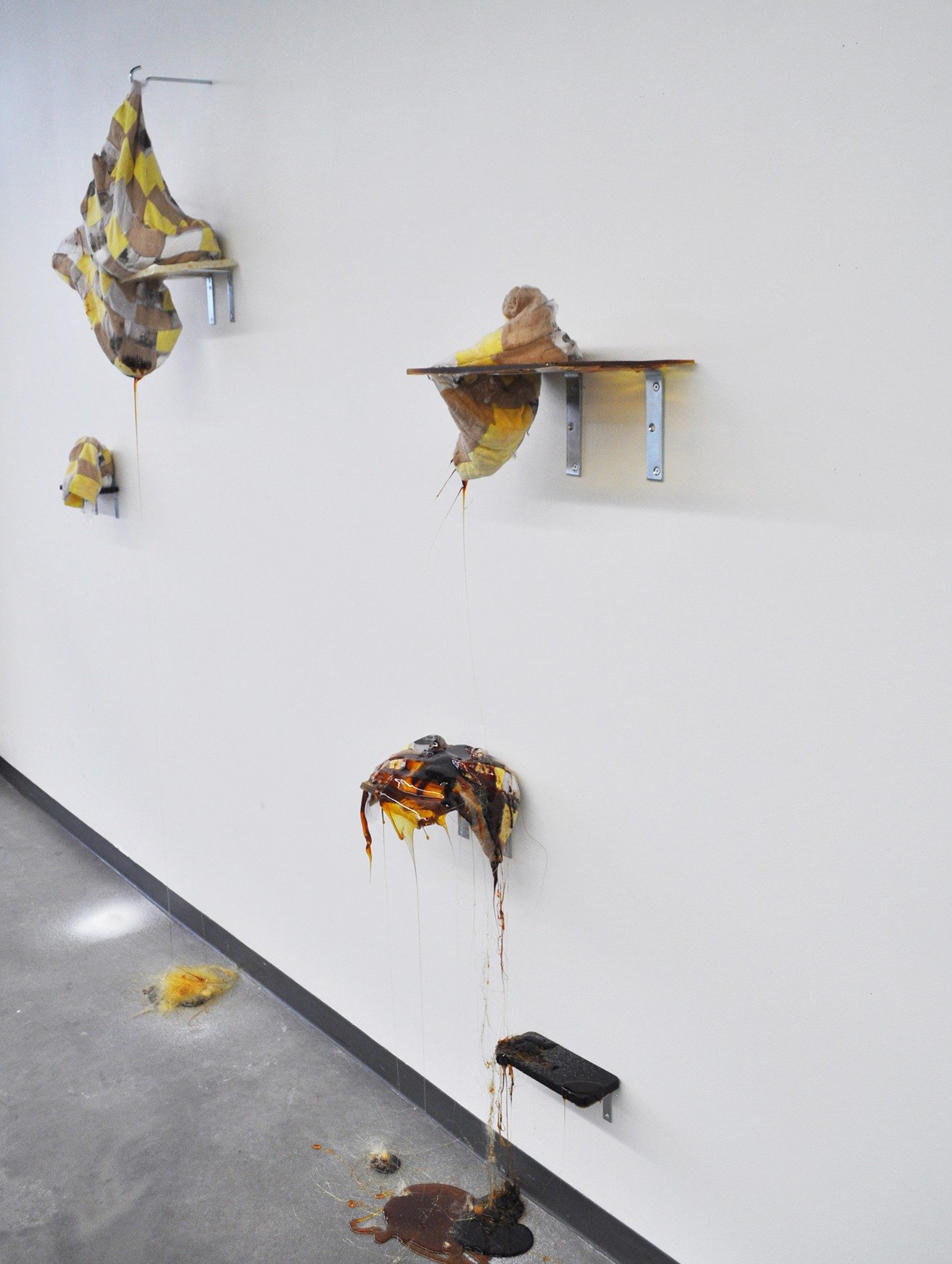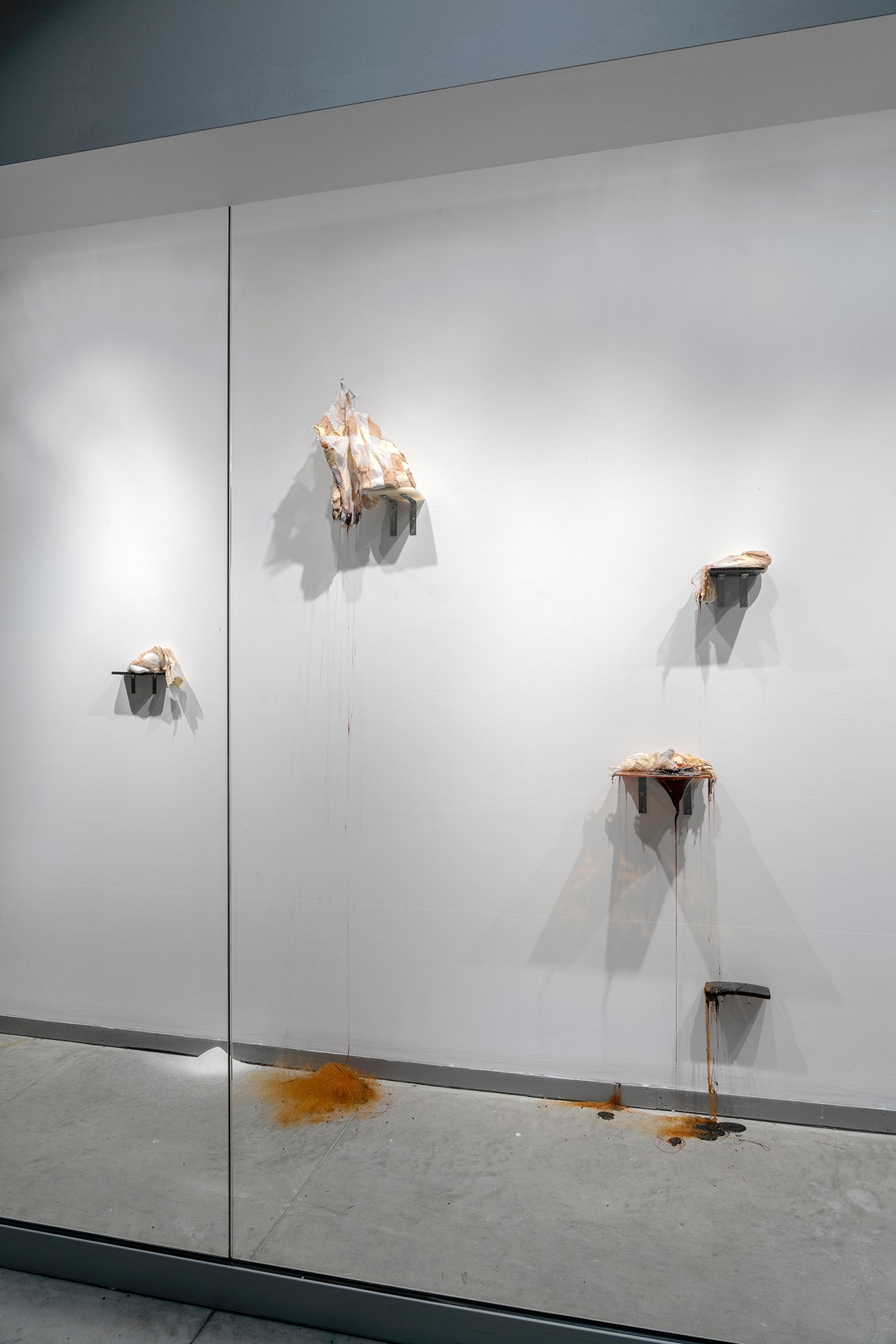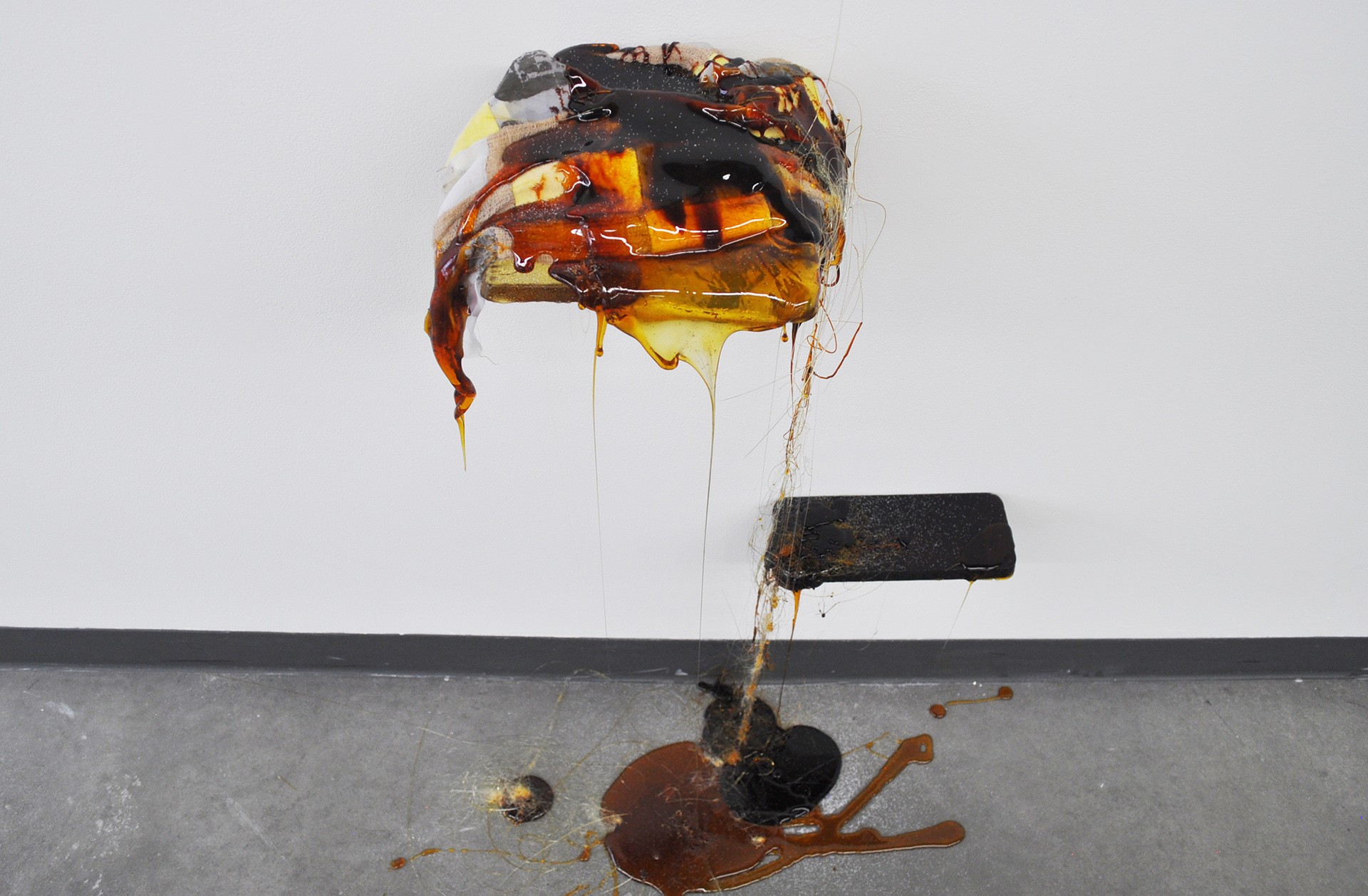KASSANDRA WALTERS
for my family
2020

Sugar, curry powder, tea, pine, ash, gauze, flannel, polyester, 6' X 7' approx.
Artist statement
In the work, for my family granulated white sugar fills soft sculptures and leaks out from where the gauze could not handle the weight, ripping apart at the seams. Placed on shelves made out of the same sugar they contain, the containers hold each other up as molten sugar, caramelized and burnt, bleeds out from one form and onto another, cascading like the waterfalls of Guyana’s landscape. Stapled closed, the forms begin to heal, in the hope that the hot sugar has cooled enough to stop flowing out and block the wounds it oozes from.
 Photo by Guy L’Heureux
Photo by Guy L’Heureux
for my family
how do I feel close to you?
to learn where you came from,
knowledge lost with the things you had to leave behind
the details that died with you
things you could not control
that were taken from us, that we never got back
already limited resources,
spread so thin there was nothing left for me
for you
how do I heal the wounds of our family?
for us
for who we were and who we are and who we will be
so they don’t have to feel like you felt, like I feel
I tried to blame you
born into oppression, carrying the hurt of our ancestors
all their wounds and my wounds
they seep from my eyes, roll down my face, pool at my feet
they weigh me down
hold me
on this earth to feel what you felt, to be close to you
thank you,
I am sorry.
 Photo by Guy L’Heureux
Photo by Guy L’Heureux
 Photo by Guy L’Heureux
Photo by Guy L’Heureux
Artist’s biography
Kassandra Walters is a multidisciplinary artist born in Tkaronto/Toronto, currently based in Tiohtiá:ke/Montreal. She combines her love of materials, mostly non-traditional, into rich, layered, ephemeral works. Her current work references her identity as a second-generation Canadian and her experiences of living with mental illness. In her most recent body of work, she uses various forms for sugar to connect to and hold space for the millions of people affected by the colonization of the Caribbean. Taking significant inspiration from the everyday, she is constantly experimenting with new materials and techniques to fulfill her ideas conceptually.

Essay
Searching for the Materiality of the Self
Author Hashmita Alimchandani
Artist Kassandra Walters
Artwork for my family, 2020
The materials of any given medium are never benign. Sculpture can be a consideration of this: What does the materiality of displacement look like? Is the viscosity of generational sacrifice something that can be contained, or frozen in time?
These are some of the questions at the core of Kassandra Walters’ sculptural installation, for my family. This work is made up of a series of sculptural pieces, combining and layering materials that make reference to Walters’ Guyanese heritage. Gunny sacks have been patchworked together from gauze and flannel, stained with curry powder and Walters’ mother’s favourite tea. Ink made from pine tree ash inscribes the message “thank you, I am sorry” on nylon mesh. These textiles — referencing Walters’ previous work in fibres — have been cut and stitched together into sacks that struggle to contain molten sugar, which appears to ooze and drip. The sacks themselves sit perched on shelves made from the same sweet, molten agricultural commodity. for my family captures the processes of material in flux, but frozen in time. Connections to displacement and generational trauma are found through fragments, through materials transformed.

Photo by Guy L’Heureux
Connections to displacement and generational trauma are found through fragments, through materials transformed.
Guyana has been a major exporter of sugar since it was colonized by the Dutch, Spanish, Portuguese, French, and British.1 Its land was exploited for its resources — a characteristically insidious colonial endeavour. The country’s economy was transformed to rely on plantations and agricultural exports. By extending the use of these seemingly everyday commodities and inserting them into her work, the artist articulates her relationship to her heritage and, ultimately, materializes her the appreciation for her family. The work also functions as a witness to her family’s emigration from Guyana to Canada. Walters states that the creation of this work also reflected her own experience of contending with her Guyanese identity, saying, “The piece went through many iterations, mirroring how I felt about my identity.”2 At the time of the work’s creation toward the end of 2020, she had been reflecting on ideas of vulnerability and the value of boundaries — themes that are also present in her other works. for my family was a means of reconciling with the fractured line between her personal, familial and Guyanese identity. The act of making and doing acts as a sort of therapy for Walters, wherein the physical thing could be equated to the meditative experience of returning to the present moment. Walters distilled this sentiment in the sugar, ultimately freezing the treacly nature of its motion in time. She found that needing to tend to the materials worked as an act of care, an extension of the work itself.
This begs the following question: where and when does an artwork begin and end? The same might be asked about identity. The self is not fixed or static. Like sugar, it is subject to being commodified and it is vulnerable to its particular environment. These sentiments may be amplified when questions of heritage are involved. The contemplation of identity is a charged experience for children of immigrants, for racialized communities, and for anyone who might walk through the world on the outlines of whatever neutrality is. For Walters, there isn’t necessarily any definitive statement to be made about these ideas. The sculptures are questions — a way of poking a hole in the material of time to create channels of conversation between individuals, between family members, which Walters confirms, saying, “the more I try to figure out what my idea means, the less clear it is, the more okay I am with that.”3 Perhaps this reflects a sound trajectory for anyone taking on the project of finding meaning within the confines of the self in relation to place, action, materiality and cultural identity.
- Kassandra Walters, On Coming to Terms (Montreal:2020).
- Kassandra Walters in conversation with the author, 07/2021.
- Ibid.
Author’s biography
Hashmita Alimchandani is a student, writer, and ceramicist living in Tiohtiá:ke/Montreal. She is the Head Writer for Yiara Magazine Volume 10, an undergraduate feminist art publication. Alimchandani has previously self-published a chapbook entitled Log and shares work via an online newsletter entitled Word Log. Through her current writing and ceramic practice, she is interested in the narrativity and agency of materiality, and considering the bounds of language as an expressive medium.

